This CE Center article is no longer eligible for receiving credits.
Design Criteria For Window Sprinkler Installations
While likely assumed by most design professionals, the AC and ESR for window sprinklers specifically requires that any use of window sprinklers must be developed with plans and details prepared by a registered design professional. In particular, one of the conditions of use is that “the registered design professional must provide the code official with documentation outlining the basis of compliance with the criteria specified by the IBC for a code modification in accordance with Section 104.10 or for an alternative method of construction in accordance with Section 104.11.” These sections provide the basis for use of the AC and ESR in this case, but the design professionals are tasked with providing the basis and design coordination.
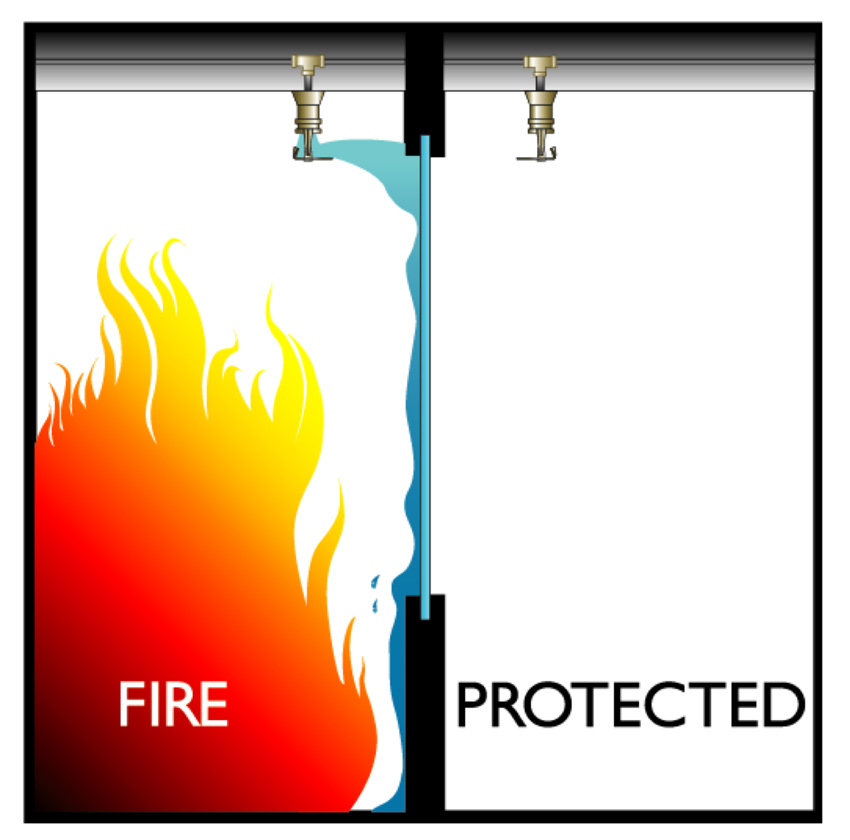
Image courtesy of Johnson Controls
The proper design of buildings using window sprinklers is meant to provide time-rated protection in the event of a fire.
In any project where window sprinklers are used, both architects and sprinkler system engineers need to work together to assure that the glass wall portion and the window sprinkler portion are coordinated and consistent with the AC and ESR specific requirements. Fortunately, most of these requirements are fairly straightforward and identified in the different sections of the ESR. Essentially, these requirements become design criteria for a particular building project and are summarized in some basic categories as follows.
General Building Design Factors
Window sprinklers, as approved by an ICC ESR, are intended to provide an alternative for up to a 2-hour fire-resistance-rated non-load-bearing interior fire barrier assembly. That means they can be a used with window panels as a substitute to non-load-bearing fire-rated partitions, such as metal stud and gypsum board assemblies, masonry, or other common partition types per IBC Sections 707 (fire barrier assemblies) and 708 (fire partition assemblies). However, they specifically, and logically, cannot be used as firewalls, which are defined by the IBC as “a fire-resistance-rated wall having protected openings, which restricts the spread of fire and extends continuously from the foundation to or through the roof, with sufficient structural stability under fire conditions to allow collapse of construction on either side without collapse of the wall,” (IBC Section 202). This is quite reasonable given the nonstructural nature of glass partitions.
Some other general criteria include:
- Exit passageways: Window sprinklers and glass partitions may not be used as fire barriers in exit passageways, horizontal exits, or exit enclosures unless the entire building is fully sprinklered in accordance with Chapter 9 of the IBC. Since most window sprinkler installations are located in buildings that are fully sprinklered, this requirement can be readily accommodated.
- Combustible materials and pony walls: All combustible materials must be kept a minimum of 2 inches away from the glass. This can be achieved by the use of a 36-inch-high “pony wall” that has a fire rating equal to the code-required rating of the partition. The rationale behind this requirement is that the pony wall would be thick enough on either side of the glass (assumed centered) to provide at least a 2-inch-thick barrier between any combustible items (furniture, etc.) and the face of the glass. The 36-inch height of the pony wall helps assure that separation. Logically, the pony wall must be constructed and shown to meet the required fire rating for the partition and must be accepted by the code official.
- Exterior walls: Although not commonly done, window sprinklers are allowable for use on an exterior wall assembly that requires a fire-resistance rating per IBC Section 705. However, zero-lot line installations are not intended here since window sprinklers used in exterior walls require a building fire separation distance greater than 5 feet under the 2006 IBC and 10 feet in subsequent versions.
- Installation and related data: Manufacturers installation instructions and other data that were the basis for an ESR must be followed for all aspects of the building design as applicable.
- Hazardous areas: The use of window sprinklers is not allowed in locations that contain materials that present deflagration or detonation hazards as defined in the code.
Window Design Factors
Having defined the general locations in the building where windows are intended to be used, there are some specific but readily achievable criteria that need to be followed regarding the glazing system used.
- Glazing: Glass must be at least ¼ inch (nominal) thickness. The glass types allowed are heat-strengthened or tempered glass. Either single- or dual-pane glazing panels are acceptable.
- Glass size: Exposed glass must not exceed 13 feet in height above the pony wall. There is no width restriction on the glass as long as the window sprinkler spacing is followed (discussed in next section). Also, the glass is required to be completely vertical and cannot be sloped or curved.
- Glazing frames: Framed glazing needs to be provided with an elastomeric seal around the entire perimeter. Unframed glazing is allowed provided the spaces between the glass panels are filled with silicone sealant.
- Horizontal mullions: Intermediate horizontal mullions are not permitted because they will interfere with the uniform distribution of water over the surface of the glazing. Therefore, the glass needs to be full height with only vertical separations.
- Operability: Window sprinklers are only allowed for inoperable, fixed glazing.
- Openings and penetrations: Glazing assemblies using window sprinklers are not permitted to incorporate penetrations of any type. Further, any opening in the assembly (i.e., doors) must be treated separately and carry its own fire-resistance rating as defined by the IBC for the particular partition condition and occupancy.
Sprinkler System Design Factors
With the building and window details determined, the following criteria shall apply to the design of the building sprinkler system in general and for the window sprinklers in particular:
- NFPA 13 requirements: Since this is still an automatic fire-protection system, the demand and hazard criteria shall be per NFPA 13. Further, all piping must be designed, sized, and installed in accordance with NFPA 13.
- Water pressure limits: Hydraulic calculations must show a maximum pressure of 175 psi for windows separated by vertical mullions and 70 psi for unframed windows.
- Water flow time: Automatic water supply systems must have the capability to supply water to the glazing assembly equal to the time of the rating (i.e., up to 2 hours).
- Window sprinkler head locations: Sprinklers must be located on both sides of the glazing. Further, the location of the sprinkler heads in relation to the glass face and the top of window must be as indicated in the AC and ESR documents. For the exposed vertical sidewall applications, that means the horizontal distance between the glass and the window sprinkler must be a minimum of 4 inches and a maximum of 12 inches, while the vertical distance between the top of the glass and the bottom of the window sprinkler should be approximately 3 inches (sprinkler below the top of glass). For the concealed vertical sidewall applications, the distance between the glass and the window sprinkler must be a minimum of 6 inches and a maximum of 12 inches, while the vertical distance between the bottom of the window frame and the top of the glass shall be 0 inches and no more than 4 inches.
- Window sprinkler head spacing: The maximum horizontal distance between window sprinkler heads is 8 feet with a minimum spacing of 6 feet.
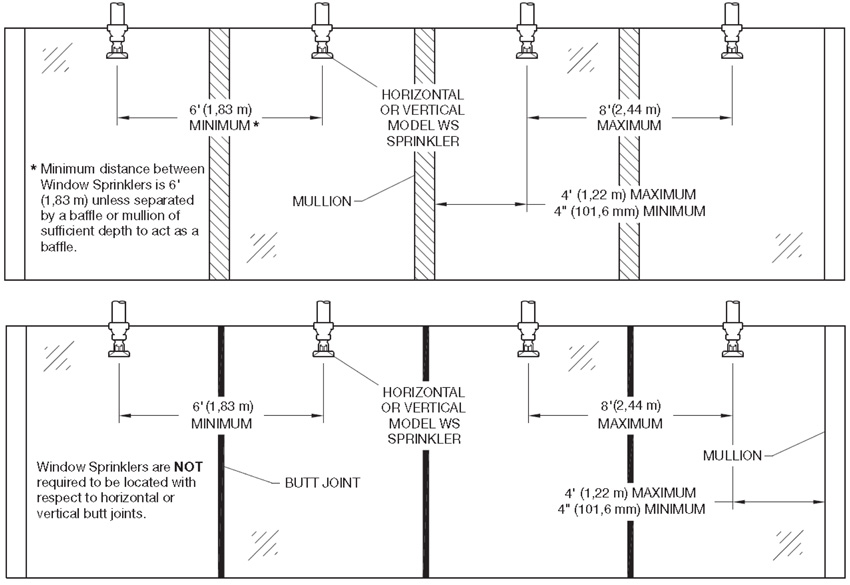
Image courtesy of Johnson Controls
The spacing of window sprinklers for windows with or without vertical mullions is dictated by AC and ESR publications as determined by testing and review.
Since this is only a summary of typical conditions, it is of course best to consult the original AC and ESR documents when working on a specific project. Note that such documents are updated from time to time, just like the IBC, so be sure to use the most current versions. For window sprinklers, the AC were first approved in 2007 and subsequently approved again in 2013. ESRs are issued and renewed on a regular basis and include some requirements for quality control by manufacturers in order to remain valid.
Cost Comparison: Window Sprinklers and Fire-rated Glass
In every construction or renovation project, cost is always an important consideration. Of course, since so many things in a building are interrelated, a change in one area of the design and construction can have implications on other parts. Nonetheless, there are some fundamental things that are readily observable when comparing the use of window sprinklers versus the use of fire-rated glass. The most obvious one is the lower cost of standard tempered or heat-strengthened glass compared to intumescent fire-rated glass—a difference on the order of 70 percent when looked at on a square foot basis of material alone. In addition, standard glass can often be quicker and easier to procure, install, and seal compared to fire-rated glass, thus saving on labor and management costs as well. One impact on the cost of related materials providing support for the glass might come from the fact that standard glass is typically lighter in weight than fire-rated glass, thus reducing the dead load on framing systems and even the structural floor systems. Finally, in the context of a full commercial building covered by the IBC, sprinkler work is likely already part of the project’s budget, so the cost of adding the extra window sprinkler piping and heads can be fairly nominal.
In order to illustrate some of the cost differences, let’s take the example of a glazed window assembly in an academic building that is 8 feet wide by 13 feet tall (maximum size allowed by AC).
- Fire-rated glass cost: According to an architect who was recently involved in such a project, he found that the uninstalled cost per square foot of fire-rated glass was approximately $90 per square foot. For our 8-by-13-feet example, that equates to 104 square feet of glass for a total cost of $9,360 for each glass panel.
- Window sprinklers with standard glass cost: When the architect looked at standard tempered glass, he found that could be budgeted for a much lower $25 per square foot, uninstalled. In our 104-square-feet example, that equates to $2,600 for the glass. In addition, the cost of two exposed window sprinklers (one on each side of the glass) needs to be accounted for. According to quotes received, that would be worth about $990 for the two, also uninstalled. Combining the glass cost with the exposed window sprinkler cost, the total comes to $3,590 for each glass panel. If the same 104-square-feet example was used again for the concealed window sprinkler option, then the cost of the glass would be $2,600 uninstalled and, according to quotes received, the two concealed window sprinklers would be worth about $1,257 uninstalled (one on each side of the glass). Therefore, the total cost using two concealed window sprinklers would be $3,857.
- Cost difference: For this example, the difference between the two fire-rated systems shows the exposed window sprinkler solution to be $5,770 less expensive, or a savings of more than 62 percent. Using the same example, the difference between the two fire-rated systems shows the concealed window sprinkler solution to be $5,503 less expensive, or a savings of more than 58 percent. Of course, that is just for one window panel - multiple windows means greater dollar savings producing greater results for the total project. So, carrying our example out further, four window panels would calculate to $37,440 for fire-rated glass vs. $14,360 for an exposed window sprinkler system, resulting in $23,080 cost savings for the project. For 12 windows, fire-rated glass would cost $112,320 compared to $43,080 for exposed window sprinklers, resulting in project cost savings of $69,240.
Overall, even without factoring in some of the related installation costs of time and labor, plus some potential weight savings, it seems apparent that the larger the project and application, the greater the value provided by the window sprinkler option compared to fire-rated glass.
The International Building Code (IBC), published by the International Code Council (ICC) and adopted by local authorities having jurisdiction (AHJs), has become the basis for demonstrating code compliance in almost all locations in the United States. One of the most common code requirements that architects need to address in commercial (i.e., nonresidential) buildings of all types is the fire separation requirements between spaces. For opaque partitions made of standard construction materials such as masonry or gypsum wall board over framing, there are many different options that have been tested and shown to be compliant. However, for partitions with significant areas of glass, the common assumption has been that some type of fire-rated glass is required to meet the code mandates of fire ratings (i.e., 1 hour, 1½ hour, 2 hour, etc.). In actuality, there is another option in the form of specific application sprinklers that have been designed and tested to meet fire-rating requirements for glass partitions. Referred to as window sprinklers, this alternative offers design flexibility, lighter-weight materials, and significant cost savings when compared to fire-rated glass.
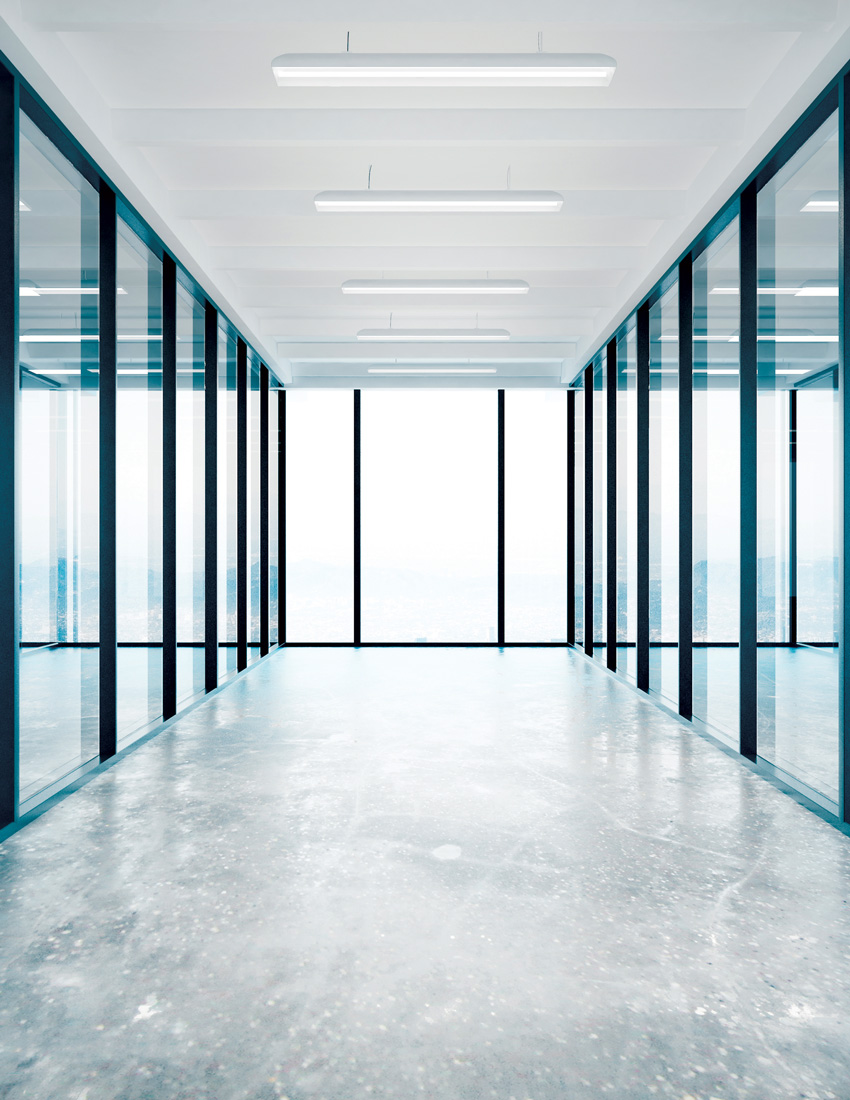
Photo courtesy of Johnson Controls
Interior glazing and windows are popular in many buildings but may require a fire rating to meet code requirements. Window sprinklers and standard glass provide an alternative to fire-rated glazing.
Window Sprinklers: A Design Choice
Let’s begin with a clear understanding of what a window sprinkler is and is not. When it comes to fire-protection systems in general, the IBC devotes all of chapter 9 to the topic. In the process, it references other code documents, including the International Fire Code and publications of the National Fire Protection Association (NFPA). Specifically, the IBC refers to standard NFPA 13 regarding automatic sprinkler systems for commercial buildings (Section 903.3.1.1) by stating, “Where the provisions of this code require that a building or portion thereof be equipped throughout with an automatic sprinkler system in accordance with this section, sprinklers shall be installed throughout in accordance with NFPA 13…” There are a few special circumstances where there are exemptions and variations for residential and manufactured housing, but otherwise NFPA 13 is the basis upon which all automatic sprinkler systems are designed and judged.
While most codes and standards are very specific and sometimes seen as limiting, they usually allow some inherent flexibility for alternative safety solutions. NFPA 13 provides for such alternatives by stating, “Nothing in this standard is intended to restrict new technologies or alternate arrangements, provided the level of safety prescribed by this standard is not lowered…” This simple statement has allowed individuals and manufacturers to recognize the limitations of existing technology and develop unique products and ideas to meet the needs of current building designs and the fire-protection community. The recognition of “new technology” that may not be specifically called out in the standard is what allows manufactures to develop alternative approaches as long as they can demonstrate equivalent performance characteristics to traditional systems.
In the case of window sprinklers, they are treated under NFPA as a type of “specific application” sprinkler. That means there can be particular conditions or applications where a sprinkler designed for a certain purpose can be manufactured and tested to demonstrate how it meets the fire safety intent of the NFPA 13 standard for a specific application. In this case, the protection of non-fire-rated glass partitions is the specific application being addressed. That makes window sprinklers different from standard ceiling-mounted sprinklers that are designed and operated to protect floor and wall surfaces. Window sprinklers are typically part of an overall automatic sprinkler system design in buildings, but the mechanical design of the manufactured sprinkler head plus the location and spacing of the installed sprinkler heads are different than in the rest of the building.
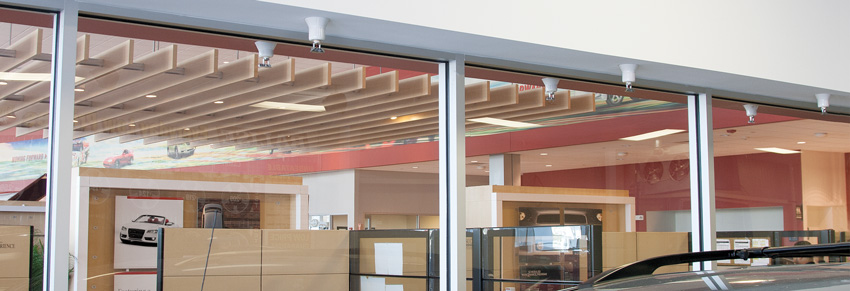
Photo courtesy of Johnson Controls
Window sprinklers used with glass partitions provide design choices that architects can use to create better building designs.
The need for window sprinklers to protect room or space separations that use large glass areas has come from many architectural and interior design schemes that use such large glass walls for a variety of reasons. In some cases, it is for literal visual transparency or observation of activities. In others, it is to enhance shared daylighting and views for building occupants. For some, it is seen as a way to help encourage collaboration and cooperation among building users while still providing some appropriate separation to control sound or other needs. Regardless of the motivation, if the partition in question where the glass is being used is required to provide any form of a fire separation (i.e., along corridors, between adjacent occupancies, etc.), the default assumption has been that fire-rated glass is needed. In some cases, the area (square inches) of the glass is limited by the code, although the type of fire-rated glass can vary. Wire glass products have been available for some time but carry a particularly institutional appearance that can obscure vision, which may not match the overall design scheme. Clear laminated glass with an intumescent layer is also available but is notably more expensive than conventional glass used for interior and exterior windows. Window sprinklers offer an alternative to both of these glass choices.
It is important to note that the use of window sprinklers needs to be paired with the glass partition design. Compatible glass includes single-glazed (single-pane), double-glazed (double-pane), or insulated glass, where each individual pane is a minimum ¼ inch (6 millimeters) thick. The glass itself needs to be either heat strengthened, tempered, or stronger. Window sprinklers are also only appropriate for vertical inoperable window assemblies, and they are not intended for operable windows or glass doors—those components need their own fire rating. This is a significant point that is sometimes misunderstood by architects and authorities having jurisdiction (AHJ), as we will discuss in the next section of this article. Nonetheless, since these compatibility criteria match most common window designs, it is easy to see why the use of window sprinkler systems has been quite successfully used in a wide range of building types, including health-care settings of all types, higher education settings such as academic and lab buildings, and commercial and corporate facilities. They have even been used successfully in multifamily settings where visual connections to common areas is desired but fire separation is required.
The unique characteristic of window sprinklers that allows them to be incorporated into all of these buildings is based on several aspects of their design. First, they use a fast response operating element that quickly dispenses water for protection of the glass wall. Second, they rely on a deflector design that wets the entire window, reaching all corners and providing full coverage. From a design coordination standpoint, the piping that the window sprinkler head is connected to can be based on either a concealed or an exposed vertical and/or horizontal installation. The more common vertical sidewall approach mimics other sprinkler installations with a vertical pipe extending down through a ceiling or soffit, leaving only the sprinkler head exposed. In this case, a side deflector is used to achieve the full and fast protection. Similar to the exposed vertical sidewall, a concealed deployable vertical sidewall is also available. The concealed vertical sidewall allows for the sprinkler piping to connect to the window sprinkler above the ceiling and uses a cover plate that is available in a standard finish or custom color finish. Another option is a horizontal sidewall approach, although less commonly used. In this case, the sprinkler piping extends down below the ceiling or soffit, making a 90-degree elbow bend to run horizontally toward the window. This application uses a different sprinkler head design that is based on it pointing directly at the glass to release water for fire protection when needed.
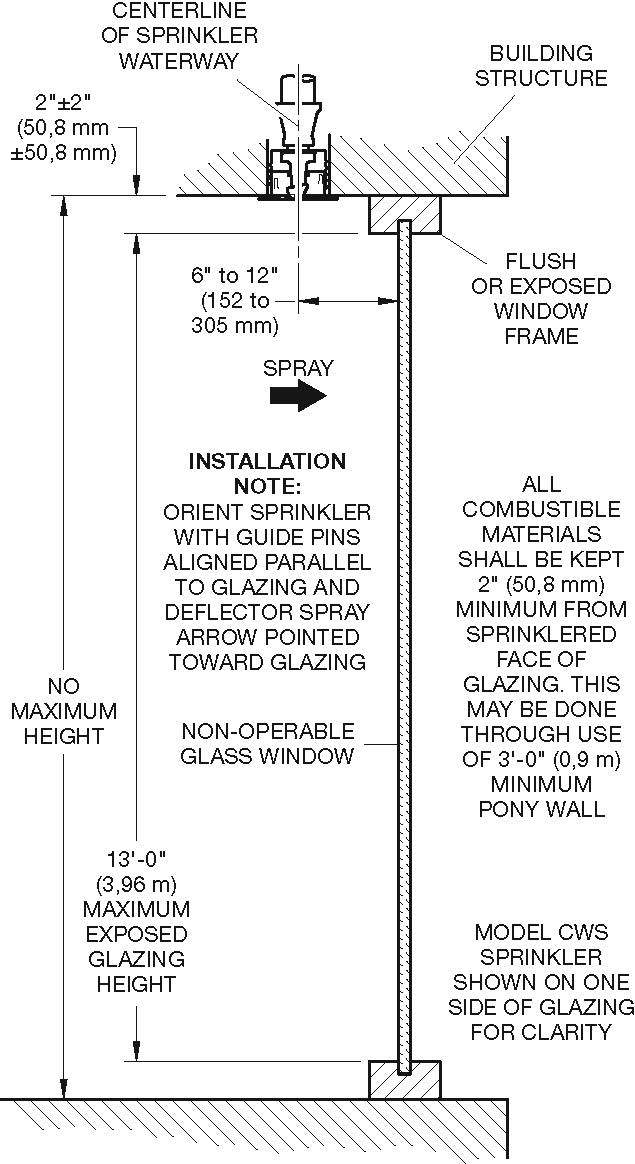
Image courtesy of Johnson Controls
Window sprinkler systems have been tested and are available in vertical sidewall, concealed vertical sidewall and horizontal sidewall applications as shown here.
Regardless of the installation method or building type, the important thing to remember is that window sprinklers are a specific type of fire-protection equipment that are different from, although readily incorporated into, a typical automatic sprinkler system. As such, they provide a coordinated automatic fire-protection solution for the part of the building with glass partitions and where traditional sprinkler heads used in other areas of the building cannot be used as a substitute to window sprinklers.
Demonstrating Window Sprinkler Code Compliance
As noted already, codes and standards require performance levels but don’t dictate the design of buildings or products. Instead they look for evidence that demonstrates performance to match the code requirements for health, safety, and welfare. In addition to the NFPA view on this point, Section 104.11 of the International Building Code reads as follows:
“The provisions of this code are not intended to prevent the installation of any materials or to prohibit any design, or method of construction not specifically prescribed by this code, provided that any such alternative has been approved. An alternative material, design or method of construction shall be approved where the building official finds that the proposed design is satisfactory and complies with the intent of the provisions of this code, and that the material, method, or work offered is, for the purpose intended, at least the equivalent of that prescribed in this code in quality, strength, effectiveness, fire resistance, durability, and safety.”
Using these code provisions as a basis, window sprinklers have undergone a rigorous but well-established process overseen by the ICC, which is summarized in the following paragraphs.
ICC Acceptance Criteria
The International Code Council operates a separate subsidiary known as the ICC Evaluation Service (ICC-ES). According to its website (www.icc-es.org), it is recognized as “an industry leader in performing technical evaluations for code compliance, providing regulators and construction professionals with clear evidence that products comply with codes and standards.” Its reputation is based on evaluations of hundreds of building products, components, methods, and materials to determine equal compliance with the ICC family of codes.

Image courtesy of ICC
Acceptance criteria researched and published by the ICC Evaluation Service is used as the generic basis for subsequent reviews of specific products or systems seeking code-compliance approval for alternatives.
The first step in conducting a review or evaluation involves the creation of generic (i.e., non-product-specific) acceptance criteria (AC), which can be looked at as the “performance specification” for a class or type of product. Accordingly, it has created and published acceptance criteria known as AC 385: Special-Purpose Sprinklers Used with Fixed Glazed Assemblies to Provide an Alternative to a Fire-Resistance-Rated Wall Assembly. As with all AC documents, it is clearly stated that “this acceptance criteria has been issued to provide interested parties with guidelines for demonstrating compliance with performance features of the codes referenced in the criteria. The criteria was developed through a transparent process involving public hearings of the ICC-ES Evaluation Committee and/or online postings where public comment was solicited.” Hence a thorough and very open process is engaged before the AC reports are crafted, reviewed, and issued.
Independent Testing
Consistent with all code-based performance, the ICC-ES relies on independent laboratory tests following code recognized testing standards. AC-385 for window sprinklers follows that practice and references the most relevant and well-known standards for fire testing. These include either ASTM E-119: Standard Test Methods for Fire Tests of Building Construction and Materials or the very similar UL 263: Standard for Fire Tests of Building Construction and Materials. Either of these tests exposes a specimen of the material or assembly being tested to a controlled fire in a test chamber with specified temperatures for a specified time period. As such, the test provides “a relative measure of the fire-test response of comparable building elements under these fire exposure conditions.” In the case of walls and partitions, it produces a measurement of the transmission of heat and the transmission of hot gases caused by the fire. The length of time that the wall or partition remains intact enough to resist the transmission of heat and hot gases at the prescribed level ultimately determines it’s fire-resistance rating (e.g., 30, 60, 90, or 120 minutes).
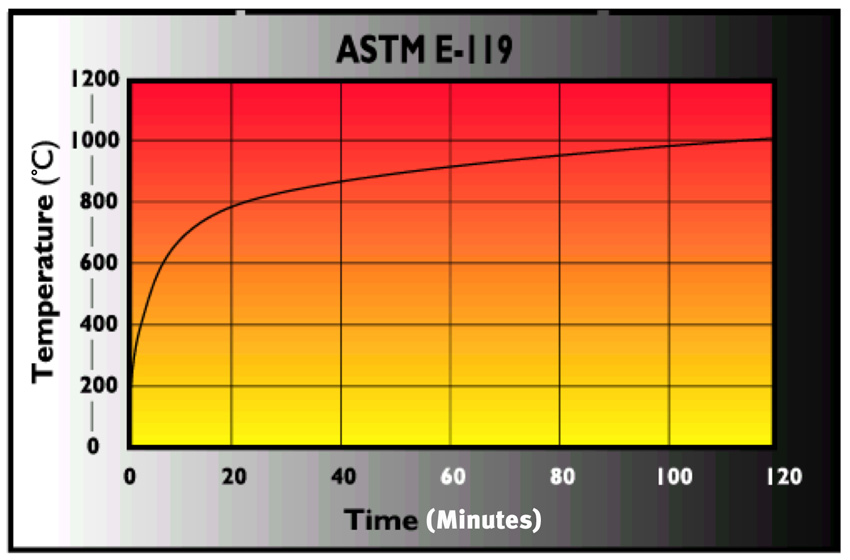
Image courtesy of Johnson Controls
Independent testing following established standards is the recognized method of determining the performance of products and systems for code compliance.
AC-385 recognizes that, under these standards, there is an inherent difference between testing an opaque wall and testing a surface that is being sprayed with water; namely, the water lowers the temperature on the test surface. Therefore, they prescribe a calibration procedure for the test chamber based on setting the test furnace at the same level of natural gas flow rate as for a gypsum wall board assembly that achieves a 3-hour rating. This calibration is the best way to achieve the time-temperature curve that is prescribed in the ASTM E119 or UL 263 standards.
Although not specifically called for in AC-385, the use of ANSI/UL 10B: Standard for Fire Tests of Door Assemblies has also been used as a relevant testing standard. Section 10 of this standard includes a hose stream test to determine how a heated surface in a partition responds to a stream of water. In this case, the surface being tested would be the window to see whether or not it cracked or had other physical damage due to the water spray. Windows with window sprinklers have undergone this test and the glass has remained intact, indicating that windows with window sprinklers are able to meet the same fire-resistance rating as fire barrier assemblies.
ICC-ES Reports
When a manufacturer has a specific product to be reviewed, then it can use the ICC-ES process to demonstrate the performance of that product. So, for window sprinklers, a manufacturer can use the AC-385 criteria and engage an independent test laboratory to conduct the requisite tests and report the results. If those results indicate that the product meets the criteria, then the manufacturer can submit that data for review to the ICC-ES and request a formal report indicating code compliance. Of course, if the test results do not indicate code-compliant performance, then the manufacturer needs to re-design or otherwise modify its product until the test results are favorable.
The difference between the ICC-ES Report (ESR) and the Acceptance Criteria document is that the ESR is issued based on the evaluation of a specific manufactured product. The ESR will follow the requirements of the AC but then apply them to the product and the information submitted for review. Typically, ESRs will identify such things as the evaluation scope (relevant code and reason for evaluation), the intended uses of the product, a general description of the product and any related systems or products inherent in their use (i.e., window sprinklers and windows), and installation details. This information makes it very clear to everyone involved what the evaluation is based on and is limited to provide a very specific, very clear assessment. In addition, the ESR will commonly indicate a few more important points, including conditions of use for achieving code-compliant performance (typically based on conditions outlined in the AC). The ESR will also identify the data submitted for review and the means of identifying the product in the field as distinct from other products.
Authorities Having Jurisdiction
All of the above steps ultimately lead up to the use of a product or system in building construction that the local authority having jurisdiction (AHJ) can review and approve for use. If the design professionals have chosen to incorporate an acceptable design alternative, such as window sprinklers, into the construction documents, then the AHJ has the duty to require documentation of acceptability of the specific products being used. Therefore, the relevant AC and ESR documents need to be listed as required submittals in project specifications so they can be reviewed by both the design professionals and the AHJ. Based on the comprehensive and open nature of developing these documents as described, all involved can reach out to the ICC-ES in the event there are any questions or concerns. More typically, the documents readily demonstrate appropriate code compliance for glazed walls.
One point that is sometimes misunderstood by architects and an AHJ is the use of window sprinklers at doors. Both the Acceptance Criteria AC 385 and the ESR reports contain the following Conditions of Use (paragraph 5.1.7 in AC 385 and 5.8 in ESR-2397): “The assembly is not permitted to incorporate penetrations. Openings must be protected in accordance with IBC requirements for opening protection.” Therefore, if an architect designs and an AHJ approves a glazed wall with doors using these specific types of special purpose window sprinklers, then code compliance can only be shown if the openings are further protected according to the IBC as required above. If not, then the doors are a breach in the fire rating since window sprinklers are not proven to be a code-compliant alternative for unrated doors, even though they may have been accepted locally. That can leave the architect of record liable in the event of a fire so diligence in the proper code-compliant protection of doors in glazed walls is important.
Design Criteria For Window Sprinkler Installations
While likely assumed by most design professionals, the AC and ESR for window sprinklers specifically requires that any use of window sprinklers must be developed with plans and details prepared by a registered design professional. In particular, one of the conditions of use is that “the registered design professional must provide the code official with documentation outlining the basis of compliance with the criteria specified by the IBC for a code modification in accordance with Section 104.10 or for an alternative method of construction in accordance with Section 104.11.” These sections provide the basis for use of the AC and ESR in this case, but the design professionals are tasked with providing the basis and design coordination.

Image courtesy of Johnson Controls
The proper design of buildings using window sprinklers is meant to provide time-rated protection in the event of a fire.
In any project where window sprinklers are used, both architects and sprinkler system engineers need to work together to assure that the glass wall portion and the window sprinkler portion are coordinated and consistent with the AC and ESR specific requirements. Fortunately, most of these requirements are fairly straightforward and identified in the different sections of the ESR. Essentially, these requirements become design criteria for a particular building project and are summarized in some basic categories as follows.
General Building Design Factors
Window sprinklers, as approved by an ICC ESR, are intended to provide an alternative for up to a 2-hour fire-resistance-rated non-load-bearing interior fire barrier assembly. That means they can be a used with window panels as a substitute to non-load-bearing fire-rated partitions, such as metal stud and gypsum board assemblies, masonry, or other common partition types per IBC Sections 707 (fire barrier assemblies) and 708 (fire partition assemblies). However, they specifically, and logically, cannot be used as firewalls, which are defined by the IBC as “a fire-resistance-rated wall having protected openings, which restricts the spread of fire and extends continuously from the foundation to or through the roof, with sufficient structural stability under fire conditions to allow collapse of construction on either side without collapse of the wall,” (IBC Section 202). This is quite reasonable given the nonstructural nature of glass partitions.
Some other general criteria include:
- Exit passageways: Window sprinklers and glass partitions may not be used as fire barriers in exit passageways, horizontal exits, or exit enclosures unless the entire building is fully sprinklered in accordance with Chapter 9 of the IBC. Since most window sprinkler installations are located in buildings that are fully sprinklered, this requirement can be readily accommodated.
- Combustible materials and pony walls: All combustible materials must be kept a minimum of 2 inches away from the glass. This can be achieved by the use of a 36-inch-high “pony wall” that has a fire rating equal to the code-required rating of the partition. The rationale behind this requirement is that the pony wall would be thick enough on either side of the glass (assumed centered) to provide at least a 2-inch-thick barrier between any combustible items (furniture, etc.) and the face of the glass. The 36-inch height of the pony wall helps assure that separation. Logically, the pony wall must be constructed and shown to meet the required fire rating for the partition and must be accepted by the code official.
- Exterior walls: Although not commonly done, window sprinklers are allowable for use on an exterior wall assembly that requires a fire-resistance rating per IBC Section 705. However, zero-lot line installations are not intended here since window sprinklers used in exterior walls require a building fire separation distance greater than 5 feet under the 2006 IBC and 10 feet in subsequent versions.
- Installation and related data: Manufacturers installation instructions and other data that were the basis for an ESR must be followed for all aspects of the building design as applicable.
- Hazardous areas: The use of window sprinklers is not allowed in locations that contain materials that present deflagration or detonation hazards as defined in the code.
Window Design Factors
Having defined the general locations in the building where windows are intended to be used, there are some specific but readily achievable criteria that need to be followed regarding the glazing system used.
- Glazing: Glass must be at least ¼ inch (nominal) thickness. The glass types allowed are heat-strengthened or tempered glass. Either single- or dual-pane glazing panels are acceptable.
- Glass size: Exposed glass must not exceed 13 feet in height above the pony wall. There is no width restriction on the glass as long as the window sprinkler spacing is followed (discussed in next section). Also, the glass is required to be completely vertical and cannot be sloped or curved.
- Glazing frames: Framed glazing needs to be provided with an elastomeric seal around the entire perimeter. Unframed glazing is allowed provided the spaces between the glass panels are filled with silicone sealant.
- Horizontal mullions: Intermediate horizontal mullions are not permitted because they will interfere with the uniform distribution of water over the surface of the glazing. Therefore, the glass needs to be full height with only vertical separations.
- Operability: Window sprinklers are only allowed for inoperable, fixed glazing.
- Openings and penetrations: Glazing assemblies using window sprinklers are not permitted to incorporate penetrations of any type. Further, any opening in the assembly (i.e., doors) must be treated separately and carry its own fire-resistance rating as defined by the IBC for the particular partition condition and occupancy.
Sprinkler System Design Factors
With the building and window details determined, the following criteria shall apply to the design of the building sprinkler system in general and for the window sprinklers in particular:
- NFPA 13 requirements: Since this is still an automatic fire-protection system, the demand and hazard criteria shall be per NFPA 13. Further, all piping must be designed, sized, and installed in accordance with NFPA 13.
- Water pressure limits: Hydraulic calculations must show a maximum pressure of 175 psi for windows separated by vertical mullions and 70 psi for unframed windows.
- Water flow time: Automatic water supply systems must have the capability to supply water to the glazing assembly equal to the time of the rating (i.e., up to 2 hours).
- Window sprinkler head locations: Sprinklers must be located on both sides of the glazing. Further, the location of the sprinkler heads in relation to the glass face and the top of window must be as indicated in the AC and ESR documents. For the exposed vertical sidewall applications, that means the horizontal distance between the glass and the window sprinkler must be a minimum of 4 inches and a maximum of 12 inches, while the vertical distance between the top of the glass and the bottom of the window sprinkler should be approximately 3 inches (sprinkler below the top of glass). For the concealed vertical sidewall applications, the distance between the glass and the window sprinkler must be a minimum of 6 inches and a maximum of 12 inches, while the vertical distance between the bottom of the window frame and the top of the glass shall be 0 inches and no more than 4 inches.
- Window sprinkler head spacing: The maximum horizontal distance between window sprinkler heads is 8 feet with a minimum spacing of 6 feet.

Image courtesy of Johnson Controls
The spacing of window sprinklers for windows with or without vertical mullions is dictated by AC and ESR publications as determined by testing and review.
Since this is only a summary of typical conditions, it is of course best to consult the original AC and ESR documents when working on a specific project. Note that such documents are updated from time to time, just like the IBC, so be sure to use the most current versions. For window sprinklers, the AC were first approved in 2007 and subsequently approved again in 2013. ESRs are issued and renewed on a regular basis and include some requirements for quality control by manufacturers in order to remain valid.
Cost Comparison: Window Sprinklers and Fire-rated Glass
In every construction or renovation project, cost is always an important consideration. Of course, since so many things in a building are interrelated, a change in one area of the design and construction can have implications on other parts. Nonetheless, there are some fundamental things that are readily observable when comparing the use of window sprinklers versus the use of fire-rated glass. The most obvious one is the lower cost of standard tempered or heat-strengthened glass compared to intumescent fire-rated glass—a difference on the order of 70 percent when looked at on a square foot basis of material alone. In addition, standard glass can often be quicker and easier to procure, install, and seal compared to fire-rated glass, thus saving on labor and management costs as well. One impact on the cost of related materials providing support for the glass might come from the fact that standard glass is typically lighter in weight than fire-rated glass, thus reducing the dead load on framing systems and even the structural floor systems. Finally, in the context of a full commercial building covered by the IBC, sprinkler work is likely already part of the project’s budget, so the cost of adding the extra window sprinkler piping and heads can be fairly nominal.
In order to illustrate some of the cost differences, let’s take the example of a glazed window assembly in an academic building that is 8 feet wide by 13 feet tall (maximum size allowed by AC).
- Fire-rated glass cost: According to an architect who was recently involved in such a project, he found that the uninstalled cost per square foot of fire-rated glass was approximately $90 per square foot. For our 8-by-13-feet example, that equates to 104 square feet of glass for a total cost of $9,360 for each glass panel.
- Window sprinklers with standard glass cost: When the architect looked at standard tempered glass, he found that could be budgeted for a much lower $25 per square foot, uninstalled. In our 104-square-feet example, that equates to $2,600 for the glass. In addition, the cost of two exposed window sprinklers (one on each side of the glass) needs to be accounted for. According to quotes received, that would be worth about $990 for the two, also uninstalled. Combining the glass cost with the exposed window sprinkler cost, the total comes to $3,590 for each glass panel. If the same 104-square-feet example was used again for the concealed window sprinkler option, then the cost of the glass would be $2,600 uninstalled and, according to quotes received, the two concealed window sprinklers would be worth about $1,257 uninstalled (one on each side of the glass). Therefore, the total cost using two concealed window sprinklers would be $3,857.
- Cost difference: For this example, the difference between the two fire-rated systems shows the exposed window sprinkler solution to be $5,770 less expensive, or a savings of more than 62 percent. Using the same example, the difference between the two fire-rated systems shows the concealed window sprinkler solution to be $5,503 less expensive, or a savings of more than 58 percent. Of course, that is just for one window panel - multiple windows means greater dollar savings producing greater results for the total project. So, carrying our example out further, four window panels would calculate to $37,440 for fire-rated glass vs. $14,360 for an exposed window sprinkler system, resulting in $23,080 cost savings for the project. For 12 windows, fire-rated glass would cost $112,320 compared to $43,080 for exposed window sprinklers, resulting in project cost savings of $69,240.
Overall, even without factoring in some of the related installation costs of time and labor, plus some potential weight savings, it seems apparent that the larger the project and application, the greater the value provided by the window sprinkler option compared to fire-rated glass.
Specifying Window Sprinkler Systems
When writing specifications for projects that incorporate window sprinkler systems instead of fire-rated glass, there are obviously two areas to pay attention to. The first will be the glass and glazing portions of the specification to be sure the appropriate criteria are met for the glass and the framing system, including sealing requirements. For projects of any moderate size, it is likely that there will be different types of glass and framing systems used, so identifying each type and their location on the drawings (i.e., interior elevations, window schedules, etc.) will be important not only for demonstrating code compliance but also for the proper installation. Similarly, the specifications and details for the pony walls under the glazing needs to be incorporated into the appropriate architectural specification sections and identified on the drawings to clearly communicate the specifics of that construction as well.
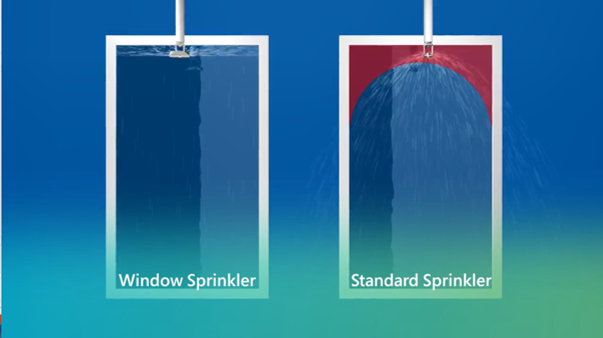
Image courtesy of Johnson Controls
When specifying window sprinklers, they need to be clearly identified as distinct from other sprinkler heads since they will perform differently.
Turning to the window sprinklers, they would normally be specified as part of the CSI/Master Format Division 21 00 00 Fire Suppression and commonly under Section 21 13 13 Wet-Pipe Sprinkler Systems. Among the items to be sure are included is an indication that the specific application type (i.e., window sprinklers) are part of the overall sprinkler system scope of work. Under submittals, the ESR or equal code-compliance documentation must be provided from the manufacturer indicating its suitability for the project. In the products portion of the specification, all common sprinkler system components are typically identified so attention needs to be called to the unique window sprinkler head types, including model numbers if possible, tied to the ESR evaluation. As part of the installation or execution portion of the specification, the ESR likely requires that manufacturer recommendations and instructions be followed so that should be reiterated here.
In short, incorporating window sprinklers into a project doesn’t typically need any additional specification sections; rather, it requires paying attention to the details of some relevant selections already included in the project. By coordinating the architectural design and specifications with the sprinkler system design and specifications, a complete, code-compliant system can be produced.
Conclusion
Buildings of all types are being designed to include glass and glazing as the means to separate and define spaces. When that separation also requires an IBC-mandated fire-resistance rating, architects and other design professionals no longer need to feel constrained to limited choices in fire-rated glass. Instead, the use of window sprinklers in accordance with established and accepted standards and reviews are an option worth considering. They have demonstrated the ability to provide equivalent protection to a 2-hour-rated partition with acceptance by code officials and notable cost savings compared to fire-rated glass. Further, they are fairly straightforward to incorporate into building design and construction consistent with other building systems.
Peter J. Arsenault, FAIA, NCARB, LEED AP, is a nationally known architect, sustainability consultant, technical writer, and continuing education presenter. www.pjaarch.com, www.linkedin.com/in/pjaarch
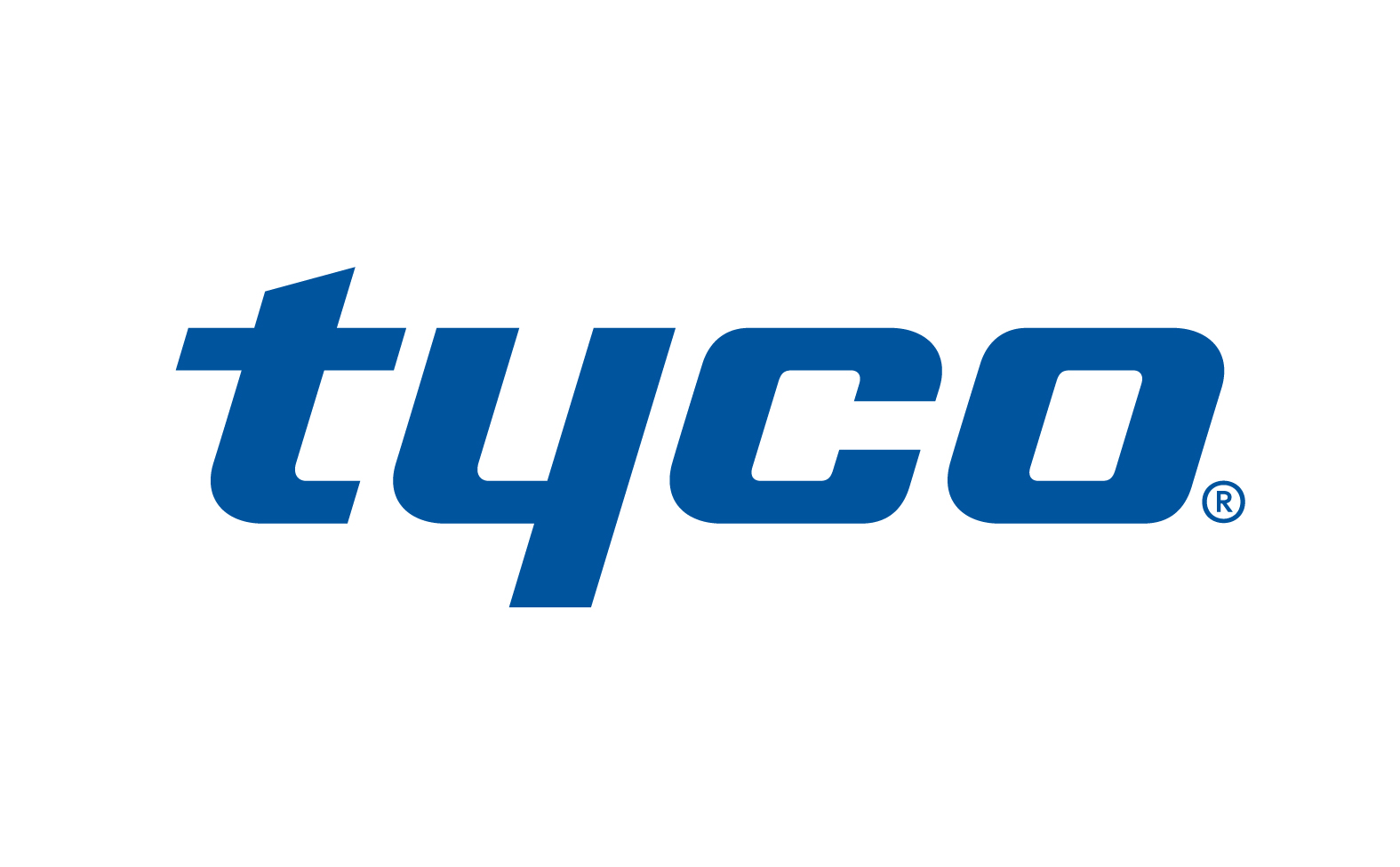
|
Tyco is the brand under which Johnson Controls, a world leader in fire suppression, manufactures fire sprinklers and valves for a variety of applications, including commercial, residential, storage, and special applications. The Tyco brand is built on more than 150 years years in the fire-protection industry. For more information, such as reports, data sheets, and design guidelines, on any of the sprinklers that are manufactured by Tyco, please visit the website or contact your local Johnson Controls (Tyco) representative.
www.tyco-fire.com
|





















